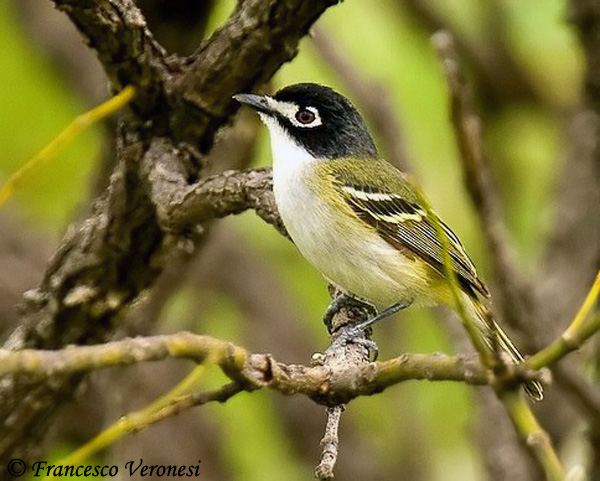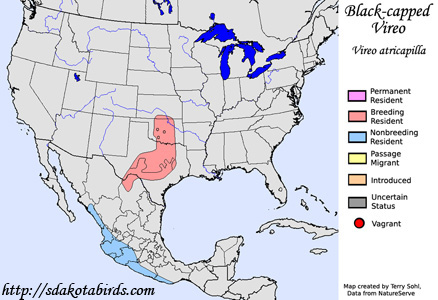| Length: 4.5 inches | Wingspan: 7 inches | Seasonality: Non-resident in South Dakota |
| ID Keys: White "spectacles" and lores on dark head, olive-green above, white below, female similar but with less plumage contrast | ||
 The
Black-capped Vireo is the smallest of our vireo species, with a limited
United States range in the southern Great Plains. There, they are
found in shrubland habitats during the summer breeding season. Numbers of
Black-capped Vireos have declined precipitously in recent decades. The
decline has largely been blamed on increased numbers of Brown-headed
Cowbirds, parasitic nesters that lay their eggs in the nests of other birds.
Habitat fragmentation has led to increased numbers of the Cowbirds, and
Black-capped Vireos are particularly susceptible to Cowbird parasitism,
given the relatively long incubation period for their eggs. Cowbird
eggs laid in the nest of a Black-capped Vireo usually hatch much earlier
than the Vireo eggs, leading the parents to raise a family of Cowbirds
rather than Vireos.
The
Black-capped Vireo is the smallest of our vireo species, with a limited
United States range in the southern Great Plains. There, they are
found in shrubland habitats during the summer breeding season. Numbers of
Black-capped Vireos have declined precipitously in recent decades. The
decline has largely been blamed on increased numbers of Brown-headed
Cowbirds, parasitic nesters that lay their eggs in the nests of other birds.
Habitat fragmentation has led to increased numbers of the Cowbirds, and
Black-capped Vireos are particularly susceptible to Cowbird parasitism,
given the relatively long incubation period for their eggs. Cowbird
eggs laid in the nest of a Black-capped Vireo usually hatch much earlier
than the Vireo eggs, leading the parents to raise a family of Cowbirds
rather than Vireos.
Habitat: Found in a variety of brushy habitats, including chaparral, pinyon-juniper shrublands, and arid thorn scrublands.
Diet: Feeds mostly on insects and spiders, particularly during the summer breeding season. They may also feed on small berries, particularly during the winter.
Behavior: Forages by climbing and flitting actively through the foliage and branches of brush and shrubs. They will also occasionally forage on the ground.
Nesting: The nest of a Black-capped Vireo is a small hanging cup placed in the fork of a small branch, built of grasses, weed stems, leaves, bark fibers, and spider webs. The female lays 2 to 5 eggs, and both parents help to incubate them. When the eggs hatch, both parents help tend to the young and feed them. The young leave the nest after about 12 days, but typically stay near the parents for several weeks after fledging.
Interactive eBird Map: Click to access an interactive eBird map of Black-capped Vireo sightings
Song: The song of a Black-capped Vireo is a series of complex, chattering phrases.
Migration: Summers in the southern Great Plains. Winters in western Mexico.
Similar Species: Blue-headed Vireo
Conservation Status: Has significantly declined in number in much of its range. The IUCN lists the Black-capped Vireo as a "Vulnerable" species.
Further Information: 1) Texas Parks and Wildlife - Black-capped Vireo
2) ARKIVE.org - Black-capped Vireo
3) Audubon Guide - Black-capped Vireo
Photo Information: Photo taken by Francesco Veronesi - April 23rd, 2009 - Texas - Photo licensed under Creative Commons Attribution NonCommercial ShareAlike 2.0 Generic License.
| Click below for a higher-resolution map |
 |
| South Dakota Status: Non-resident in South Dakota |
Additional Black-capped Vireo Photos (coming soon!!)
